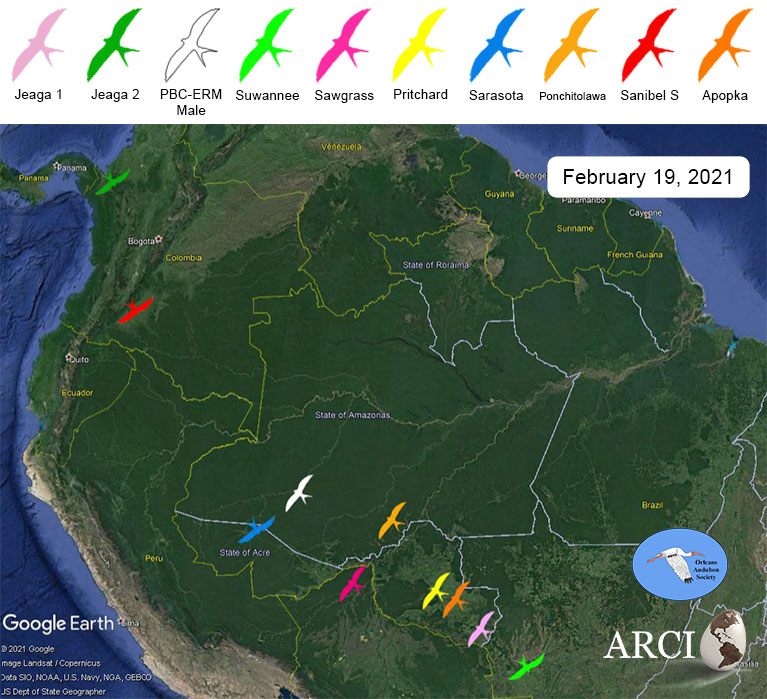
Since our last update, five GPS-tracked kites have started their northbound migration! The Avian Research and Conservation Institute (ARCI) currently tracks 10 Swallow-tailed Kites outfitted with GPS transmitters.
On 23 January 2021, a Swallow-tailed Kite named PBC-ERM Male was the first to start its northbound migration. He is now in the state of Amazonas in Brazil and is the farthest north of all the kites we are tracking.
The best news of the week was the break in “radio silence” from Prichard, a male Swallow-tailed Kite from Palmetto Bluff, South Carolina. We had not received a transmission from Prichard since September 2020. He had spent the winter in a remote area of Mato Grosso, Brazil and as he started north, he encountered cell towers that uploaded his backlogged data. He is in Rondônia, Brazil now.
The three kites that were the farthest south, in the Brazilian state of Mato Grosso do Sul, started north the first week of February; Ponchitolawa, tagged by our colleague Dr. Jennifer Coulson in Louisiana; Sawgrass, from Pinellas County, Florida; and Jeaga #1 from Palm Beach County, Florida. Sawgrass and Ponchitolawa left on the same day from the same roost but they are taking slightly different routes north. Sawgrass, on a more western route, is crossing the Bolivian Amazon, while Ponchitolawa is travelling a little further to the east. Jeaga #1 departed three days later, and is now in Rondônia, Brazil.
Suwannee’s last location was northwest of Cuiabá in the state of Mato Grosso, Brazil and Apopka was in the state of Rondônia, Brazil, both uploaded last in late January. We hope to get a data uploads soon from Suwannee and Apopka as they start back to their US breeding grounds.
Three other kites have been out of cell range for a few months; Sarasota last uploaded data from Acre, Brazil and both Sanibel South and Jeaga #2 last checked in from Colombia.
Of course, as amazing as this remote tracking technology is, it remains imperfect. The timing of cellular-data uploads from kites on their winter range and during migration can be spotty due to a lack of cell coverage in remote areas. We sometimes go months without receiving data uploads, having to wait patiently for the birds to move within cell-tower range and upload GPS location collected since the signal’s last transmission.
Last year almost half of the kites we are currently tracking had shown unusual deviations in their southbound migratory routes. We wonder if large-scale changes in climate conditions or agricultural practices could be causing these changes. The accumulation of certain toxic agricultural chemicals (e.g., neonicotinoids, which have been proven to cause fatal disorientation in migrant songbirds) may be threatening Swallow-tailed Kites during their arduous 10,000-mile round trip annual migration. As we continue to evaluate the progress of these kites throughout their lives, questions like these are at the forefront of our minds.
Audubon Center for Birds of Prey
bioGraphic
Caloosa Bird Club
Clearwater Audubon Society
CROW – Clinic for the Rehabilitation of Wildlife, Inc.
Florida Panther National Wildlife Refuge
Friends of Palmetto Bluff Conservancy
Friends of the Carlton Reserve
Friends of the Florida Panther Refuge
Friends of the Lower Suwannee & Cedar Keys National Wildlife Refuges
Halifax River Audubon
Jacksonville Zoo and Garden
Lower Suwannee National Wildlife Refuge
National Audubon Society
Oklawaha Valley Audubon Society
Orange Audubon Society
Orleans Audubon Society
Palm Beach County Department of Environmental Resources Management
Palm Beach Zoo and Conservation Society
Palmetto Bluff Conservancy
Peace River Audubon Society
Sanibel-Captiva Audubon Society
Sanibel-Captiva Conservation Foundation SCCF
Sarasota Audubon Society
Seminole Audubon Society
St. Augustine Alligator Farm Zoological Park
St. Petersburg Audubon Society
Sunrise Wildlife Rehabilitation
The Avian Reconditioning Center for Birds of Prey
Venice Area Audubon Society
West Volusia Audubon

Leave a Reply